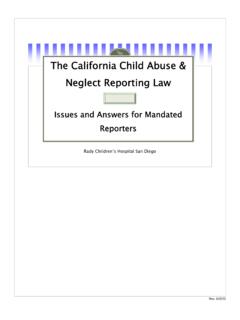Transcription of Initial Assessment or Investigation - Child Welfare
1 38 IntakeChild Protective Services: A Guide for Caseworkers 39 39 CHAPTER 6 Initial Assessment or InvestigationCaseworkers feel pressure from many different directions children, families, statutory and agency expectations, and themselves. Family members who are reported to Child protective services (CPS) typically feel embarrassed, defensive, angry, confused, threatened, and helpless. As families experience these feelings, they need the CPS caseworker to provide them with information to understand what they are accused of, what may happen, what the next steps are, what they can expect from the agency, and what they are expected to do. The agency expects the caseworker to meet the statutory deadlines by quickly gathering information about the children and family and determining if maltreatment occurred, the likelihood that it will occur again, and the threat of immediate serious harm to the Child . At the same time caseworkers should manage their own fears and doubts Is the Child really safe?
2 What else could I have done?41 This chapter describes the purposes of the Initial Assessment or Investigation to gather and analyze information in response to CPS reports, to interpret the agency s role to the children and families, and to determine which families will benefit from further agency intervention. After interviewing all parties and gathering all relevant information, CPS caseworkers must determine whether maltreatment has occurred and can be substantiated. In most States, CPS staff are mandated by law to determine whether the report is substantiated or founded (meaning that credible evidence indicates that abuse or neglect has occurred) or whether the report is unsubstantiated or unfounded (meaning that there is a lack of credible evidence to substantiate Child maltreatment but does not mean it did not necessarily occur). Depending on State law, CPS agencies usually have up to 30, 60, or 90 days after receiving the report to complete the Initial Assessment or Investigation .
3 A major part of the Initial Assessment or Investigation includes determining whether there is a risk or likelihood of maltreatment occurring in the future and whether the Child is safe (not at risk of imminent, serious harm). In addition, CPS caseworkers must decide whether ongoing services to reduce risk and assure Child safety should be provided by the CPS agency or other community partners. This chapter addresses the following: Effective Initial Assessment or Investigation characteristics Initial Assessment or Investigation decisions Initial Assessment or Investigation processes Interviewing techniques Community involvement Special practice issues 40 Initial Assessment or InvestigationChild Protective Services: A Guide for Caseworkers 41 40 EFFECTIVE Initial Assessment OR Investigation CHARACTERISTICSIn cooperative investigations, CPS workers form an alliance with both the children and family. In a well-handled Investigation , the worker: Involves the children and family during the exploration of the allegations to gain their perceptions of the allegations; Focuses on the children s, the parent s, and the family s strengths and resources; their plans for building protective factors; and past and present actions to protect the children; Listens carefully to the family s experience to make sure they know they have been heard and understood; Demonstrates sensitivity and empathy regarding the anxiety experienced by the children and family; Communicates clearly and openly CPS s statutory role; Focuses on small steps, making sure the children and family understand each one; Involves the children and family in the decisions that affect them by providing choices and opportunities for input; Demonstrates flexibility in the interview.
4 Focuses on gathering comprehensive information rather than trying to identify solutions, which is best left for later in the casework Initial Assessment OR Investigation DECISIONSTo make effective decisions during the Initial Assessment or Investigation process, the CPS caseworker must have competent interviewing skills; be able to gather, organize, and analyze information; and arrive at accurate conclusions. Critical decisions that must be made at this stage of the CPS process include the following: Is Child maltreatment substantiated as defined by State statute or agency policy? Is the Child at risk of maltreatment, and what is the level of risk? Is the Child safe and, if not, what type of agency or community response will ensure the Child s safety in the least intrusive manner? If the Child s safety cannot be assured within the family, what type and level of care does the Child need? Does the family have emergency needs that must be met?
5 Should ongoing agency services be offered to the family?Decision Point One:Substantiating MaltreatmentThe substantiation decision depends on the answers to two questions: Is the harm to the Child severe enough to constitute Child maltreatment? and Is there sufficient evidence to support this being a case of Child maltreatment? 43 Even in those cases lacking evidence, CPS caseworkers should still document information since unsubstantiated reports may eventually show a pattern that can be substantiated. Due to varying State regulations regarding the expungement of records, this may not be possible for all agencies. Upon completion of the Initial Assessment , the caseworker must determine the disposition of the report based on State laws, agency guidelines, and the information gathered. CPS agencies use different terms for this decision substantiated, confirmed, unsubstantiated, founded, or unfounded.
6 To guide 40 Initial Assessment or InvestigationChild Protective Services: A Guide for Caseworkers 41caseworker judgment in making the substantiation decision, each State has developed policies that outline what constitutes credible evidence that abuse or neglect has occurred. Most States have a two-tiered system: substantiated-unsubstantiated or founded-unfounded. Some States have a three-tiered system of substantiated, indicated, or unsubstantiated. The indicated classification means the caseworker has some evidence that maltreatment occurred, but not enough to substantiate the case. At this point in the decision-making process, caseworkers should ask themselves: Have I obtained enough information from the children, family, and collateral contacts to adequately reach a determination about the alleged abuse or neglect? Is my decision on substantiation based upon a clear understanding of State laws and agency policies?
7 Have I assessed the need for other agency or community services when CPS intervention is not warranted?44 The following sections discuss substantiation decisions for different types of maltreatment Child neglect, physical abuse , sexual abuse , and psychological Child NeglectDetermining Child neglect is based on the answers to two questions: Do the conditions or circumstances indicate that a Child s basic needs are unmet? and What harm or threat of harm may have resulted? 45 Answering these questions requires sufficient information to assess the degree to which omissions in care have resulted in significant harm or significant risk of harm. Unlike the other forms of maltreatment, this determination may not be reached by looking at one incident; the decision often requires looking at patterns of care over time. The analysis should focus on examining how the Child s basic needs are met and identifying situations that may indicate specific omissions in care that have resulted in harm or the risk of harm to the answers to the following questions may indicate that a Child s physical and medical needs are unmet: Have the parents or caregivers failed to provide the Child with needed care for a physical injury, acute illness, physical disability, or chronic condition?
8 Have the parents or caregivers failed to provide the Child with regular and ample meals that meet basic nutritional requirements, or have the parents or caregivers failed to provide the necessary rehabilitative diet to the Child with particular health problems? Have the parents or caregivers failed to attend to the cleanliness of the Child s hair, skin, teeth, and clothes? It is difficult to determine the difference between marginal hygiene and neglect. Caseworkers should consider the chronicity, extent, and nature of the condition, as well as the impact on the Child . Does the Child have inappropriate clothing for the weather and conditions? Caseworkers must consider the nature and extent of the conditions and the potential consequences to the Child . Does the home have obvious hazardous physical conditions? For example, homes with exposed wiring or easily accessible toxic substances. Does the home have obvious hazardous unsanitary conditions?
9 For example, homes with feces- or trash-covered flooring or furniture. Does the Child experience unstable living conditions? For example, frequent changes of residence or evictions due to the caretaker s mental illness, substance abuse , or extreme poverty? Do the parents or caregivers fail to arrange for a safe substitute caregiver for the Child ? 42 Initial Assessment or InvestigationChild Protective Services: A Guide for Caseworkers 43 Have the parents or caregivers abandoned the Child without arranging for reasonable care and supervision? For example, have caregivers left children without information regarding their whereabouts?47 While State statutes vary, most CPS professionals agree that children under the age of 8 who are left alone are being neglected. It is also agreed that children older than 12 are able to spend 1 to 2 hours alone each day. In determining whether neglect has occurred, the following issues should be considered, particularly when children are between the ages of 8 and 12: The Child s physical condition and mental abilities, coping capacity, maturity, competence, knowledge regarding how to respond to an emergency, and feelings about being alone.
10 Type and degree of indirect adult supervision. For example, is there an adult who is checking in on the Child ? The length of time and frequency with which the Child is left alone. Is the Child being left alone all day, every day? Is he or she left alone all night? The safety of the Child s environment. For example, the safety of the neighborhood, access to a telephone, and safety of the Physical AbuseIn determining whether physical abuse occurred, the key questions to answer are Could the injury to the Child have occurred in a nonabusive manner? and Does the explanation given plausibly explain the physical findings? 48 The caseworker must gather information separately from the Child , the parents, and other possible witnesses regarding the injuries. The following questions may help determine if abuse occurred: Does the explanation fit the injury? For example, the explanation of a baby falling out of a crib is not consistent with the Child having a spiral fracture.













